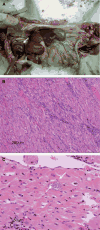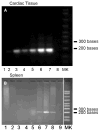Polymerase chain reaction detection of Trypanosoma cruzi in Macaca fascicularis using archived tissues
- PMID: 19635875
- PMCID: PMC2740910
Polymerase chain reaction detection of Trypanosoma cruzi in Macaca fascicularis using archived tissues
Abstract
This study describes conventional and real-time polymerase chain reaction (PCR) methods developed to detect and quantify Trypanosoma cruzi DNA in cynomolgus monkeys (Macaca fascicularis) using formalin-fixed paraffin-embedded blocks archived for periods of up to 6 years. The highest concentration of T. cruzi DNA was found in the myocardium, urinary bladder, stomach, lymph node, adrenal gland, and colon. The concentration of T. cruzi DNA detected in cardiac tissues was 10-100-fold greater than found elsewhere; the mean concentrations of T. cruzi DNA in non-cardiac tissues were otherwise comparable. Trypanosoma cruzi DNA was amplified from cerebrum but not cerebellum or kidney. Successful use of DNA from formalin-fixed, paraffin-embedded blocks is important because most pathology laboratories routinely archive wax blocks. This archived resource can be used for further studies on the prevalence of this disease.
Figures



Similar articles
-
Correlation between presence of Trypanosoma cruzi DNA in heart tissue of baboons and cynomolgus monkeys, and lymphocytic myocarditis.Am J Trop Med Hyg. 2014 Apr;90(4):627-33. doi: 10.4269/ajtmh.13-0448. Epub 2014 Feb 24. Am J Trop Med Hyg. 2014. PMID: 24567317 Free PMC article.
-
Amplification of Trypanosoma cruzi-specific DNA sequences in formalin-fixed raccoon tissues using polymerase chain reaction.J Parasitol. 2002 Oct;88(5):989-93. doi: 10.1645/0022-3395(2002)088[0989:AOTCSD]2.0.CO;2. J Parasitol. 2002. PMID: 12435142
-
Serial 'deep-sampling' PCR of fragmented DNA reveals the wide range of Trypanosoma cruzi burden among chronically infected human, macaque, and canine hosts, and allows accurate monitoring of parasite load following treatment.Elife. 2025 Apr 15;14:RP104547. doi: 10.7554/eLife.104547. Elife. 2025. PMID: 40232944 Free PMC article.
-
Molecular characterization and diagnosis of trypanosoma cruzi and T. rangeli.Arch Med Res. 2002 Jul-Aug;33(4):362-70. doi: 10.1016/s0188-4409(02)00380-6. Arch Med Res. 2002. PMID: 12234526 Review.
-
[Detection of molecular heterogeneity of Trypanosoma cruzi].Rev Soc Bras Med Trop. 2005;38 Suppl 2:77-83. Rev Soc Bras Med Trop. 2005. PMID: 16482821 Review. Spanish.
Cited by
-
VNI cures acute and chronic experimental Chagas disease.J Infect Dis. 2013 Aug 1;208(3):504-11. doi: 10.1093/infdis/jit042. Epub 2013 Jan 31. J Infect Dis. 2013. PMID: 23372180 Free PMC article.
-
Immunopathologic characterization of naturally acquired Trypanosoma cruzi infection and cardiac sequalae in cynomolgus macaques (Macaca fascicularis).J Am Assoc Lab Anim Sci. 2013 Sep;52(5):545-52. J Am Assoc Lab Anim Sci. 2013. PMID: 24041209 Free PMC article.
-
Phenotypic and Functional Signatures of Peripheral Blood and Spleen Compartments of Cynomolgus Macaques Infected With T. cruzi: Associations With Cardiac Histopathological Characteristics.Front Cell Infect Microbiol. 2021 Jul 14;11:701930. doi: 10.3389/fcimb.2021.701930. eCollection 2021. Front Cell Infect Microbiol. 2021. PMID: 34336723 Free PMC article.
-
Extracellular vesicles of Trypanosoma cruzi and immune complexes they form with sialylated and non-sialylated IgGs increase small peritoneal macrophage subpopulation and elicit different cytokines profiles.Front Immunol. 2023 Aug 2;14:1215913. doi: 10.3389/fimmu.2023.1215913. eCollection 2023. Front Immunol. 2023. PMID: 37600828 Free PMC article.
-
Correlation between presence of Trypanosoma cruzi DNA in heart tissue of baboons and cynomolgus monkeys, and lymphocytic myocarditis.Am J Trop Med Hyg. 2014 Apr;90(4):627-33. doi: 10.4269/ajtmh.13-0448. Epub 2014 Feb 24. Am J Trop Med Hyg. 2014. PMID: 24567317 Free PMC article.
References
-
- World Health Organization. Second Report of the WHO Expert Committee. Geneva: World Health Organization; 2002. Control of Chagas Disease. Technical Report Series, No. 905.
-
- Hagar JM, Rahimtoola SH. Chagas’ heart disease in the United States. N Engl J Med. 1991;325:763–768. - PubMed
-
- Kirchhoff LV. American trypanosomiasis (Chagas’ disease)—a tropical disease now in the United States. N Engl J Med. 1993;329:639–644. - PubMed
-
- Schofield CJ, Dias JC. The Southern Cone Initiative against Chagas disease. Adv Parasitol. 1999;42:1–27. - PubMed
Publication types
MeSH terms
Substances
Grants and funding
LinkOut - more resources
Full Text Sources
Medical
